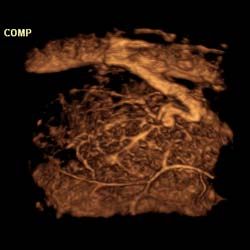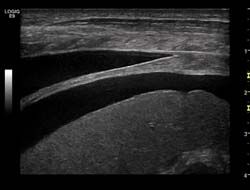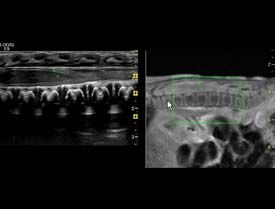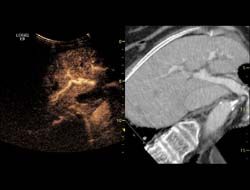- AI
- Molecular Imaging
- CT
- X-Ray
- Ultrasound
- MRI
- Facility Management
- Mammography
Emergence of elastography gives renewed impetus and vigor to ultrasound market
Elastography is one of the emerging technologies on display at ECR 2009, reflecting the growing importance of imaging techniques that compare the inherent stiffness of healthy and abnormal tissues in advancing the diagnostic value of ultrasound. Elastography’s clinical applications were discussed at two separate satellite symposia on Saturday and Sunday.
Elastography is one of the emerging technologies on display at ECR 2009, reflecting the growing importance of imaging techniques that compare the inherent stiffness of healthy and abnormal tissues in advancing the diagnostic value of ultrasound. Elastography's clinical applications were discussed at two separate satellite symposia on Saturday and Sunday.

3D contrast-enhanced ultrasound vascular rendering of colon cancer metastasis. (Provided by GE Healthcare)
The principles behind elastography may date back to the earliest days of medicine, when Hippocrates and his followers used manual palpation to help characterize tumors, but there is nothing old-fashioned about the technologies for further developing those concepts in the technical exhibition.
Established in 2005, SuperSonic Imagine, based in Aix-en-Provence, France, is making its first appearance at the congress. Its Aixplorer scanner incorporates ideas to meet the demand for ever faster processing of ultrasound data from a surprising source -- the video games industry.
"Companies that make these games have very similar requirements to our own. They need to process a huge amount of data very quickly if the movement of figures on the screen is to appear lifelike," said founder and CEO Jacques Souquet. "So we have adapted some of the key hardware elements -- microprocessors, graphics boards -- to be part of our software-driven technology. The result is that we are able to acquire data at a rate of 10,000 frames per second. Conventional cardiac ultrasound machines can capture 200 to 500 images per second."
Aixplorer provides quantifiable measurements of tissue stiffness. The transducer sends the pulses necessary to generate tissue deformation. A disadvantage of previous systems is that they require the operator to compress the tissue, and so the results may depend on that person's skills and training.

Philips continues to expand clinical capabilities of its premium iU22 platform. (Provided by Philips Healthcare)
SuperSonic's technology was developed initially for use in breast imaging, but there are plans to develop a number of other clinical applications, including the detection of thyroid nodules, liver fibrosis, and prostate disease. The company's satellite symposium followed a symposium about real-time tissue elastography organized by Hitachi Medical Systems.
Hitachi has 25 years of experience in designing and manufacturing ultrasound systems, and ECR 2009 is unveiling its latest platform, HI VISION Preirus, which features a new system architecture developed through collaboration between the company's imaging division and its central research laboratory. Two of the key benefits of the new product are its flexibility and user-friendliness, and it has a unique ergonomic design that adapts to any scanning environment, style of examination, and operator position, according to Hitachi. Its second-generation graphical user interface combines extrawide image display with a Smart Touch Control Panel to give the operator better control of the system and to improve the screen display.
The company states that its latest offering provides the highest image quality, optimized patient-to-patient with one key operation using the PSS (Patient Specific Selector) function. This also allows the operator to employ combinations of multiple scanning parameters and sophisticated signal processing technologies, which can be customized and switched simultaneously in one key operation. Above all, it offers next-level performance on many Hitachi original technologies, such as real-time tissue elastography, and is compatible with the company's extensive range of transducers while introducing new single-crystal probe technology, the company said.
Another ultrasound satellite symposium, organized by GE Healthcare, was entitled "Agile acoustic architecture, the most recent innovation in modern ultrasound." The vendor highlighted the clinical utility of its new LOGIQ E9 platform. This unit incorporates the company's proprietary Agile Acoustique architecture and is based on beamformer technology. It can process up to 3 GB of data per second, which is around 30 times faster than conventional ultrasound machines.
By combining high technical specifications with a range of advanced applications, GE is hoping to change the way that ultrasound is used within a typical hospital radiology department.

Thoracic diaphragm wall was examined using high-frequency matrix linear transducer. (Provided by GE Healthcare)
"Ultrasound has always stood apart from the rest of the work in the department, and it has been seen as something of a sideline," said Pierre Radzikowski, marketing manager for the company's European ultrasound business. "But with our system's fusion imaging tool, we can provide information that can be combined with previously acquired information from CT, MR, or any other DICOM data source. Ultrasound can be repositioned as a key modality in the diagnosis, treatment planning, and monitoring of interventions."
The product's V Nav package offers the GPS function. This tool allows the clinician to track markers in the patient's body placed on lesions, erosions, or other anatomical features. The positional information can be stored on the unit's hard drive and compared with the images obtained on follow-up to check the efficacy of treatment.

Side-by-side fusion imaging of real-time high-frequency ultrasound and MR images show pediatric spine in neonate with meningitis. (Provided by GE Healthcare)
GE is not the only imaging giant to be unveiling its latest hardware at ECR 2009. Siemens is will demonstrating the capabilities of the Acuson S2000 Automated Breast Volume Scanner (ABVS), a multi-use, automated volume breast ultrasound system. This automatically and quickly acquires full-field sonographic volumes for comprehensive review and diagnosis of the breast, streamlining workflow and reducing operator dependence and variability. The system also features the intuitive anatomical coronal plane, which is not available using conventional ultrasound. This view provides a more understandable representation of the global anatomy and architecture of the breast.
"I believe ABVS can make a significant contribution in diagnostic confidence for women with dense breast tissue and inconclusive mammograms. Examinations performed with this new technology generally take less than 15 minutes, which is time well spent if you consider the extended diagnostic capabilities of ultrasound in dense breasts," said Bernd Montag, CEO of Siemens' imaging and IT division.

Preprocedure liver imaging: dual-view fusion imaging of real-time contrast-enhanced ultrasound with previously acquired CT volume data set. (Provided by Dr. T. De Baère, Institut Gustave-Roussy, Paris)
ZONARE Medical Systems, based in Mountain View, CA, has also been investigating new solutions for imaging challenging patients. At ECR, it is demonstrating technology designed to provide better quality imaging of patients who are overweight, elderly, or very muscular, or who have a thick body wall. The company has created new proprietary software for its ZONE Sonography technology.
"When combined with our new C3-0.5 transducer, clinicians have an important new tool for imaging their most technically difficult patients with advanced image clarity," said Lars Shaw, ZONARE's vice president for marketing.
Finally, Philips has announced the Vision 2009 upgrade, a fourth major enhancement of its iU22 product. The iU22 ultrasound unit now offers tissue aberration correction on breast transducers to compensate for speed of sound variations of dense tissue, improving detail resolution and conspicuity of lesion details.
The Reading Room: Racial and Ethnic Minorities, Cancer Screenings, and COVID-19
November 3rd 2020In this podcast episode, Dr. Shalom Kalnicki, from Montefiore and Albert Einstein College of Medicine, discusses the disparities minority patients face with cancer screenings and what can be done to increase access during the pandemic.
